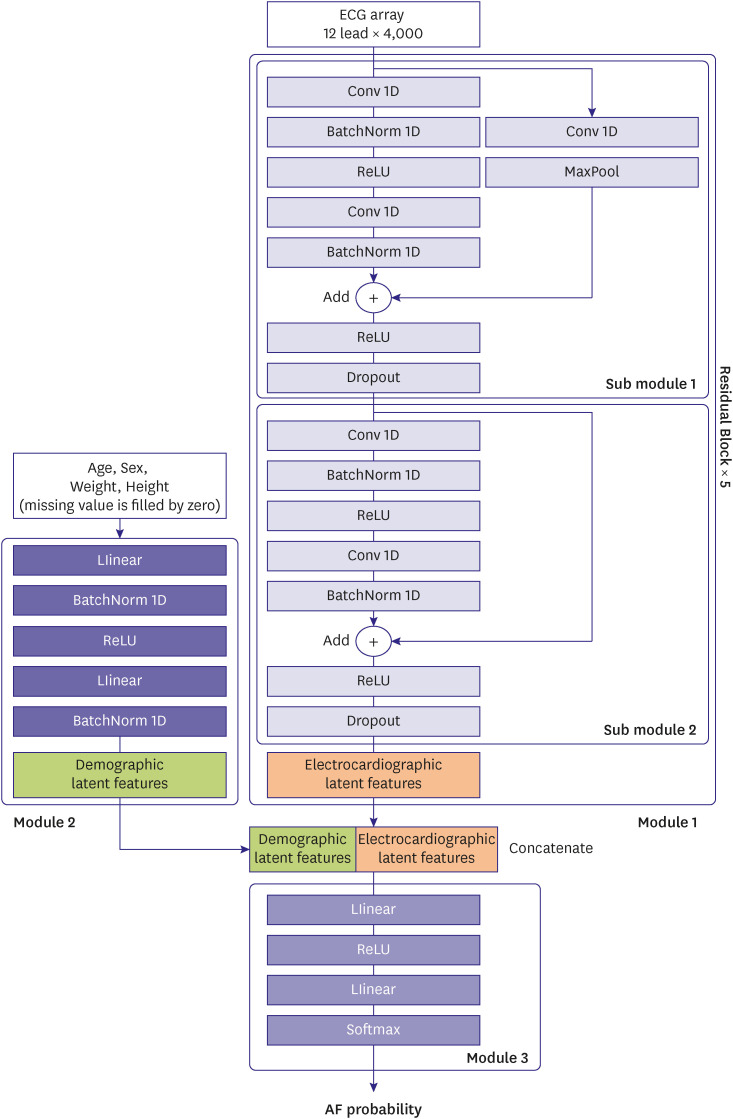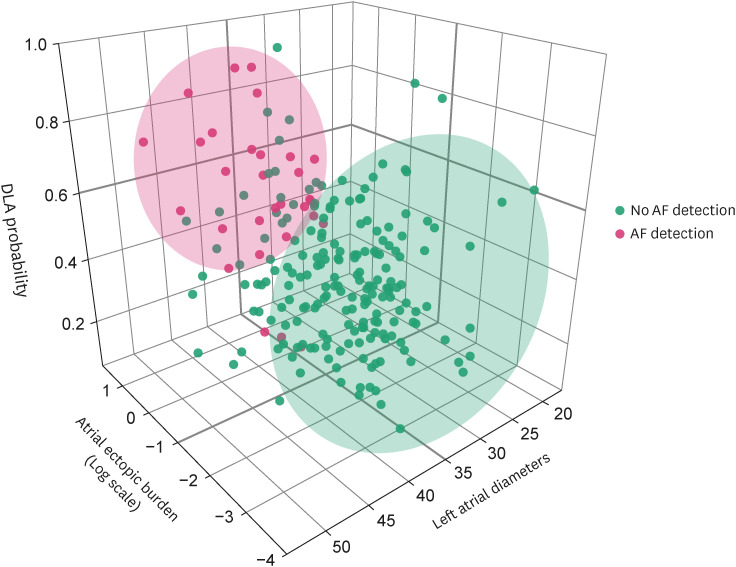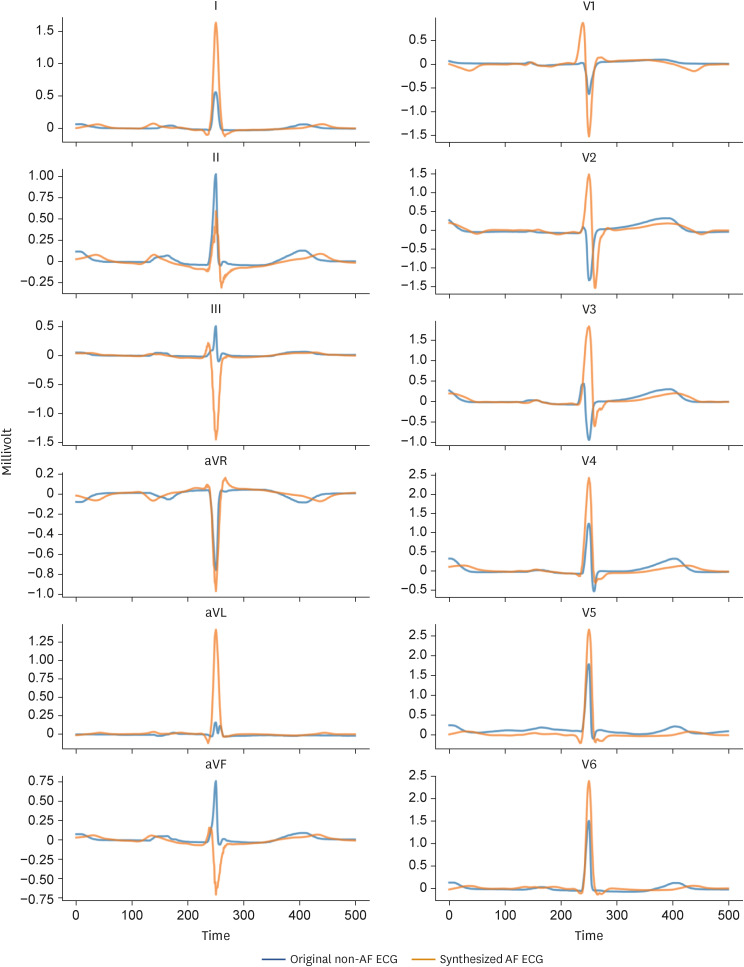Korean Circ J.
2023 Nov;53(11):758-771. 10.4070/kcj.2023.0009.
Identifying Atrial Fibrillation With Sinus Rhythm Electrocardiogram in Embolic Stroke of Undetermined Source: A Validation Study With Insertable Cardiac Monitors
- Affiliations
-
- 1Division of Cardiology, Department of Internal Medicine, Seoul National University Bundang Hospital, Seongnam, Korea
- 2Medical Research Team, Medical AI Inc., San Francisco, CA, USA
- 3Department of Critical Care and Emergency Medicine, Incheon Sejong Hospital, Incheon, Korea
- KMID: 2548238
- DOI: http://doi.org/10.4070/kcj.2023.0009
Abstract
- Background and Objectives
Paroxysmal atrial fibrillation (AF) is a major potential cause of embolic stroke of undetermined source (ESUS). However, identifying AF remains challenging because it occurs sporadically. Deep learning could be used to identify hidden AF based on the sinus rhythm (SR) electrocardiogram (ECG). We combined known AF risk factors and developed a deep learning algorithm (DLA) for predicting AF to optimize diagnostic performance in ESUS patients.
Methods
A DLA was developed to identify AF using SR 12-lead ECG with the database consisting of AF patients and non-AF patients. The accuracy of the DLA was validated in 221 ESUS patients who underwent insertable cardiac monitor (ICM) insertion to identify AF.
Results
A total of 44,085 ECGs from 12,666 patient were used for developing the DLA. The internal validation of the DLA revealed 0.862 (95% confidence interval, 0.850–0.873) area under the curve (AUC) in the receiver operating curve analysis. In external validation data from 221 ESUS patients, the diagnostic accuracy of DLA and AUC were 0.811 and 0.827, respectively, and DLA outperformed conventional predictive models, including CHARGE-AF, C2HEST, and HATCH. The combined model, comprising atrial ectopic burden, left atrial diameter and the DLA, showed excellent performance in AF prediction with AUC of 0.906.
Conclusions
The DLA accurately identified paroxysmal AF using 12-lead SR ECG in patients with ESUS and outperformed the conventional models. The DLA model along with the traditional AF risk factors could be a useful tool to identify paroxysmal AF in ESUS patients.
Figure
Cited by 1 articles
-
Artificial Intelligence-enhanced Electrocardiogram for Atrial Fibrillation in Embolic Stroke With Undetermined Source: Heroic Detective or Overfitting Alarm?
Yong-Soo Baek
Korean Circ J. 2023;53(11):772-774. doi: 10.4070/kcj.2023.0231.
Reference
-
1. Ntaios G. Embolic stroke of undetermined source: JACC review topic of the week. J Am Coll Cardiol. 2020; 75:333–340. PMID: 31976872.2. Kirchhof P, Benussi S, Kotecha D, et al. 2016 ESC Guidelines for the management of atrial fibrillation developed in collaboration with EACTS. Europace. 2016; 18:1609–1678. PMID: 27567465.
Article3. Ziegler PD, Rogers JD, Ferreira SW, et al. Long-term detection of atrial fibrillation with insertable cardiac monitors in a real-world cryptogenic stroke population. Int J Cardiol. 2017; 244:175–179. PMID: 28624331.
Article4. Li YG, Pastori D, Farcomeni A, et al. A simple clinical risk score (C2HEST) for predicting incident atrial fibrillation in Asian subjects: derivation in 471,446 Chinese subjects, with internal validation and external application in 451,199 Korean subjects. Chest. 2019; 155:510–518. PMID: 30292759.
Article5. Suenari K, Chao TF, Liu CJ, Kihara Y, Chen TJ, Chen SA. Usefulness of HATCH score in the prediction of new-onset atrial fibrillation for Asians. Medicine (Baltimore). 2017; 96:e5597. PMID: 28072697.
Article6. Alonso A, Krijthe BP, Aspelund T, et al. Simple risk model predicts incidence of atrial fibrillation in a racially and geographically diverse population: the CHARGE-AF consortium. J Am Heart Assoc. 2013; 2:e000102. PMID: 23537808.
Article7. Kwon JM, Jeon KH, Kim HM, et al. Comparing the performance of artificial intelligence and conventional diagnosis criteria for detecting left ventricular hypertrophy using electrocardiography. Europace. 2020; 22:412–419. PMID: 31800031.
Article8. Kwon JM, Cho Y, Jeon KH, et al. A deep learning algorithm to detect anaemia with ECGs: a retrospective, multicentre study. Lancet Digit Health. 2020; 2:e358–e367. PMID: 33328095.
Article9. Siontis KC, Noseworthy PA, Attia ZI, Friedman PA. Artificial intelligence-enhanced electrocardiography in cardiovascular disease management. Nat Rev Cardiol. 2021; 18:465–478. PMID: 33526938.
Article10. Attia ZI, Noseworthy PA, Lopez-Jimenez F, et al. An artificial intelligence-enabled ECG algorithm for the identification of patients with atrial fibrillation during sinus rhythm: a retrospective analysis of outcome prediction. Lancet. 2019; 394:861–867. PMID: 31378392.
Article11. Hannun AY, Rajpurkar P, Haghpanahi M, et al. Cardiologist-level arrhythmia detection and classification in ambulatory electrocardiograms using a deep neural network. Nat Med. 2019; 25:65–69. PMID: 30617320.
Article12. Hart RG, Diener HC, Coutts SB, et al. Embolic strokes of undetermined source: the case for a new clinical construct. Lancet Neurol. 2014; 13:429–438. PMID: 24646875.
Article13. Lee JH, Moon IT, Cho Y, et al. Left atrial diameter and atrial ectopic burden in patients with embolic stroke of undetermined source: risk stratification of atrial fibrillation with insertable cardiac monitor analysis. J Clin Neurol. 2021; 17:213–219. PMID: 33835741.
Article14. Li YG, Bisson A, Bodin A, et al. C2 HEST score and prediction of incident atrial fibrillation in poststroke patients: a French nationwide study. J Am Heart Assoc. 2019; 8:e012546. PMID: 31234697.
Article15. Barrett TW, Self WH, Wasserman BS, McNaughton CD, Darbar D. Evaluating the HATCH score for predicting progression to sustained atrial fibrillation in ED patients with new atrial fibrillation. Am J Emerg Med. 2013; 31:792–797. PMID: 23478104.
Article16. Shih SM, Tien PJ, Karnin Z. GANMEX: One-vs-one attributions guided by GAN-based counterfactual explanation baselines. arXiv. 2020; [Epub ahead of print].17. Lang O, Gandelsman Y, Yarom M, et al. Explaining in style: training a GAN to explain a classifier in StyleSpace. arXiv. 2021; [Epub ahead of print].
Article18. Hindricks G, Potpara T, Dagres N, et al. 2020 ESC Guidelines for the diagnosis and management of atrial fibrillation developed in collaboration with the European Association for Cardio-Thoracic Surgery (EACTS): The Task Force for the diagnosis and management of atrial fibrillation of the European Society of Cardiology (ESC) Developed with the special contribution of the European Heart Rhythm Association (EHRA) of the ESC. Eur Heart J. 2021; 42:373–498. PMID: 32860505.19. Pürerfellner H, Sanders P, Sarkar S, et al. Adapting detection sensitivity based on evidence of irregular sinus arrhythmia to improve atrial fibrillation detection in insertable cardiac monitors. Europace. 2018; 20:f321–f328. PMID: 29036652.
Article20. Tao Y, Xu J, Gong X, Sun J, Yang D. Premature atrial complexes can predict atrial fibrillation in ischemic stroke patients: a systematic review and meta-analysis. Pacing Clin Electrophysiol. 2021; 44:1599–1606. PMID: 34170567.
Article21. Selvaraju RR, Cogswell M, Das A, Vedantam R, Parikh D, Batra D. Grad-CAM: visual explanations from deep networks via gradient-based localization. Int J Comput Vis. 2020; 128:336–359.
Article22. Smith JW, O’Neal WT, Shoemaker MB, et al. PR-interval components and atrial fibrillation risk (from the Atherosclerosis Risk in Communities Study). Am J Cardiol. 2017; 119:466–472. PMID: 27889043.
Article23. Mandyam MC, Soliman EZ, Alonso A, et al. The QT interval and risk of incident atrial fibrillation. Heart Rhythm. 2013; 10:1562–1568. PMID: 23872693.
Article24. Xiang H, Xue Y, Chen Z, et al. The association between left ventricular hypertrophy and the occurrence and prognosis of atrial fibrillation: a meta-analysis. Front Cardiovasc Med. 2021; 8:639993. PMID: 34395549.
Article25. Hart RG, Catanese L, Perera KS, Ntaios G, Connolly SJ. Embolic stroke of undetermined source: a systematic review and clinical update. Stroke. 2017; 48:867–872. PMID: 28265016.26. Sanna T, Diener HC, Passman RS, et al. Cryptogenic stroke and underlying atrial fibrillation. N Engl J Med. 2014; 370:2478–2486. PMID: 24963567.
Article27. Himmelreich JC, Lucassen WA, Harskamp RE, Aussems C, van Weert HC, Nielen MM. CHARGE-AF in a national routine primary care electronic health records database in the Netherlands: validation for 5-year risk of atrial fibrillation and implications for patient selection in atrial fibrillation screening. Open Heart. 2021; 8:e001459. PMID: 33462107.
Article28. Lip GY, Skjøth F, Nielsen PB, Larsen TB. Evaluation of the C2HEST risk score as a possible opportunistic screening tool for incident atrial fibrillation in a healthy population (from a Nationwide Danish Cohort Study). Am J Cardiol. 2020; 125:48–54. PMID: 31711634.
Article
- Full Text Links
- Actions
-
Cited
- CITED
-
- Close
- Share
- Similar articles
-
- The Mechanism of and Preventive Therapy for Stroke in Patients with Atrial Fibrillation
- How and When to Screen for Atrial Fibrillation after Stroke: Insights from Insertable Cardiac Monitoring Devices
- Spontaneous Conversion of Atrial Fibrillation to Normal Sinus Rhythm Following Recurrent Cerebral Infarctions
- Left Atrial Diameter and Atrial Ectopic Burden in Patients with Embolic Stroke of Undetermined Source: Risk Stratification of Atrial Fibrillation with Insertable Cardiac Monitor Analysis
- Artificial Intelligence-enhanced Electrocardiogram for Atrial Fibrillation in Embolic Stroke With Undetermined Source: Heroic Detective or Overfitting Alarm?






